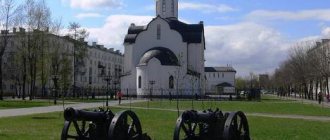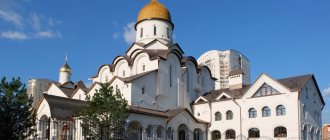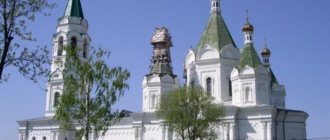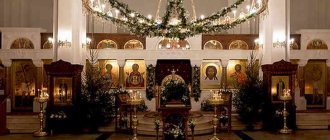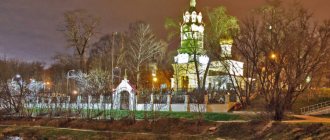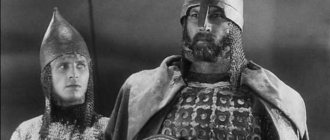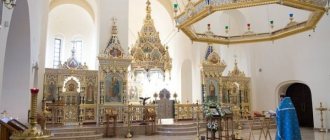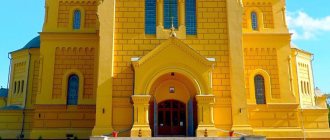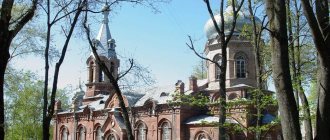Mir
Russia Tula region Temple of Alexander Nevsky (Tula) Map loading in progress...
{"format":"leaflet","minzoom":false,"maxzoom":false,"limit":50,"offset":0,"link":"all","sort":[""], "order":[],"headers":"show","mainlabel":"","intro":"","outro":"","searchlabel":"\u2026 \u0441\u043b\u0435\ u0434\u0443\u044e\u0449\u0438\u0435 \u0440\u0435\u0437\u0443\u043b\u044c\u0442\u0430\u0442\u044b","default":"","import-annotation":false,"width ":"auto","height":"350px","centre":{"text":"","title":"""link":"","lat":54.19055999999999784222382004372775554656982421875,"lon": 37.59969399999999950523488223552703857421875,"icon":""},"title":"","label":"","icon":"","lines":[],"polygons":[],"circles":[ ],"rectangles":[],"copycoords":false,"static":false,"zoom":8,"defzoom":14,"layers":["OpenStreetMap"],"image layers":[] ,"overlays":[],"resizable":false,"fullscreen":true,"scrollwheelzoom":true,"cluster":false,"clustermaxzoom":9,"clusterzoomonclick":true,"clustermaxradius":80, "clusterspiderfy":true,"geojson":"","clicktarget":"","showtitle":true,"hidenamespace":false,"template":"","userparam":"","activeicon": "","pagelabel":false,"ajaxcoordproperty":"","ajaxquery":"","locations":[{"text":"\u003Cb\u003E\u003Ca href=\"/palomnik/%D0% A5%D1%80%D0%B0%D0%BC_%D0%90%D0%BB%D0%B5%D0%BA%D1%81%D0%B0%D0%BD%D0%B4%D1%80% D0%B0_%D0%9D%D0%B5%D0%B2%D1%81%D0%BA%D0%BE%D0%B3%D0%BE_(%D0%A2%D1%83%D0%BB%D0 %B0)\» title=\»\u0425\u0440\u0430\u043c \u0410\u043b\u0435\u043a\u0441\u0430\u043d\u0434\u0440\u0430 \u041d\u0435\u0432\u0441\u04 3a\u043e\ u0433\u043e (\u0422\u0443\u043b\u0430)\»\u003E\u0425\u0440\u0430\u043c \u0410\u043b\u0435\u043a\u0441\u0430\u043d\u0434\u0440 \u0430 \u041d\u0435\ u0432\u0441\u043a\u043e\u0433\u043e (\u0422\u0443\u043b\u0430)\u003C/a\u003E\u003C/b\u003E\u003Chr /\u003E\u003Ca href=\»/palomnik/%D0% A1%D0%B2%D0%BE%D0%B9%D1%81%D1%82%D0%B2%D0%BE:%D0%90%D0%BD%D0%BD%D0%BE%D1%82 %D0%B0%D1%86%D0%B8%D1%8F\" title=\"\u0421\u0432\u043e\u0439\u0441\u0442\u0432\u043e:\u0410\u043d\u043d\u043e\u0442\ u0430\u0446\u0438\u044f\»\u003E\u0410\u043d\u043d\u043e\u0442\u0430\u0446\u0438\u044f\u003C/a\u003E: »'\u0425\u0440\u0430\u0 43c\u0410\u043b \u0435\u043a\u0441\u0430\u043d\u0434\u0440\u0430 \u041d\u0435\u0432\u0441\u043a\u043e\u0433\u043e"' \u2014 \u043f\u0440\u04 30\u0432\u043e\u0441\u043b \u0430\u0432\u043d\u044b\u0439 \u0445\u0440\u0430\u043c \u0432 \u0422\u0443\u043b\u0435. \u0425\u0440\u0430\u043c \u0410\u043b\u0435\u043a\u0441\u0430\u043d\u0434\u0440\u0430 \u041d\u0435\u0432\u0441\u043a\u043e\ u0433\u043e\u0431\u044b\u043b 1886 1886 1886 1886 \u0435\u0440\u0443\u0441\u0441\ u043a\u043e\u043c \u0441\u0442\u0438\u043b\u0435 \u0441 \u043e\u0434\u043d\u043e\u0439 \u0448\u043b\u0435\u043c\u043e\u0432\ u0438\u0434\u043d\u043e\u0439\ u0433\u043b\u0430\u0432\u043e\u0439.","title":"\u0425\u0440\u0430\u043c \u0410\u043b\u0435\u043a\u0441\u0430\u043d\u0434\u0440\u0 430\u041d\ u0435\u0432\u0441\u043a\u043e\u0433\u043e (\u0422\u0443\u043b\u0430)","link":"","lat":54.1905599999999978422238200437277555465698242 1875,"lon":37.59969399999999950523488223552703857421875,"icon":"" }],"imageLayers":[]}
54.188323; 37.592455
Russia, Tula region, Tula municipality, Soviet territorial district
Tula region
Russia
Phone fax:
(8-4872)21-13-00
Temple of Alexander Nevsky
- Orthodox church in Tula. The Alexander Nevsky Temple was built in 1886 in the Old Russian style with one helmet-shaped dome.
History[edit]
In the documents of the Tula Spiritual Consistory Foundation there is a case about the construction of a new church in the name of St. Alexander Nevsky (for 1863-1884) at the expense of the Tula 3rd Guild of merchant Efim Kharitonovich Kuchin, who donated eight Moscow tickets for it according to his spiritual will Safe Treasury for the amount of 20 thousand rubles in silver, with interest: “This church should be built in the name of Alexander Nevsky, the Angel of our pious Sovereign Emperor Alexander Nikolaevich and in memory of His Imperial Majesty’s liberation of the peasants from serfdom according to the Highest Manifesto on February 19, 1861. with a chapel in the name of St. Euthymius, whose memory is celebrated on October 15" (F.3. Op.28 D.585. L.3-3 vol.) The temple was supposed to be built in the 2nd city part of Tula “on the parade ground, which is near the gendarmerie stables.” The second name of this place is Gendarme Square (now Alexander Nevsky Square at the intersection of S. Perovskaya and Pushkinskaya streets).
By order of the City Duma, the initial design of the temple was drawn up by the architect of the Tula Arms Factory, Mikhailov. Its size exceeded the amount donated. Kuchin's heir, merchant L.S. Golovin, entered into an agreement with the city architect Bashkirov to draw up a new plan and facade of the church. Construction began in 1881.
In the clergy register of the Alexander Nevsky Church in Tula for 1915 it is written: built in 1885, consecrated in 1886 “through the diligence of the Tula City Society with capital donated by the merchant Evfimy Kharitonovich Kuchin - in the amount of 67,919 rubles. The building is stone, warm, and has no special bell tower. The temple was built in memory of the liberation of peasants from serfdom, the chapel in the name of the Venerable Martyr Evdokia - in memory of the martyrdom of Emperor Alexander II, which followed on March 1, 1881; chapel in the name of St. Euthymius the New, October 15, in memory of the testator of the capital" (F. 3. Op. 17. D. 1043. L. 2).
There are three altars in the temple: the main one is in the name of St. blgv. Prince Alexander Nevsky, on the right - in the name of St. Euphemia, on the left - in the name of the Holy Martyr. Evdokia. The staff included: 2 priests, 2 psalm-readers. The size of the church land was 320 square meters. soot Houses for clergy were built with funds from benefactors in 1886, 1898, 1905 and belonged to the church. She also owned wooden buildings: 1) for a parochial school, 2) for an almshouse and elderly women, 3) for a gatehouse. The parish includes 297 houses, where 737 men and 836 women lived in 1916.
An inventory of church property was started in 1885. Copies of metric books were kept since 1886, confessional records since 1887. There were 60 books in the church library. Since 1889, a parochial school has been opened at the temple, where 67 boys and 37 girls studied in 1915.
The clergy register contains the name of the church elder - court councilor Andrei Andreevich Lyubomudrov.
Photos of the early 20th century
In the file on the activities of the parish trusteeship, created in 1888 at the Alexander Nevsky Church, there is its report for 1895, which states: “a member of the trusteeship, N.N. Logachev, donated an icon of the Mother of God, called “It is Worthy to Eat,” ordered by him from Athos, and then N.F. Sokolova donated the icon of St. Nicholas the Wonderworker, painted on Athos, and finally I.I. Ivanov donated the icon of Joachim and Daria to the temple. In addition, court councilor V.I. Volocheninov sent a gift of one hundred birch trees and five hundred pines and firs to plant in the square near the temple” (F. 3. Op. 7. D. 3947. L. 2-2 vol.).
In the file on the opening of a free public library at the Alexander Nevsky Church for 1896, the library’s charter is kept.
In the documents of the Foundation “Executive Committee of the Tula City Council of People's Deputies” there is a resolution of the City Council of February 6, 1930 approved by the Moscow Regional Executive Committee on February 16, 1930 on the closure of the church.
June 22, 2001 – registration of the parish community of the Church of St. Alexander Nevsky;
April 17, 2003 – the rector of the temple was appointed (Priest Viktor Ryabovol);
April 24, 2003 - on Maundy Thursday the first Divine Liturgy took place after the closure of the church.
Founding history
The history of the construction of this unique Tula pearl of Orthodoxy is interesting. The merchant of the Third Guild, Efim Kharitonovich Kuchina, in 1863 left a spiritual will and funds for the construction of a new temple in Tula in honor of the guardian angel of Emperor Alexander Nikolaevich Alexander Nevsky and in memory of the abolition of serfdom in Rus'.
Temple of Alexander Nevsky in Tula
Gendarme Square, now renamed Alexander Nevskaya, was chosen as the construction site. The City Duma invited the architect Bashkirov, who had supervised the construction of the shrine since 1881, to draw up the project.
The warm, stone church was erected by 1885, and consecration took place in 1886.
Current state[edit]
Currently, parish life is being revived, restoration work is underway, a military-patriotic Sunday school for boys has been created, a parish library has been opened, and cooperation with the Tula 106th Airborne Division and the special forces detachment “Grif” is developing.
The church operates a Sunday school, a family club, and “Mother’s School.”
We are working with WWII veterans.
With the blessing of the Bishop, the temple takes special care of alcohol and drug addicts.
Since 2010, a society of Orthodox doctors has been caring for the church.
There is a library and a church shop.
The Tula city Cossack community is cared for at the temple.
Architecture and decoration of the building
Currently, the church has been completely restored, except for four small chapters, which have never been restored. The architectural style has been preserved in its original form as Old Russian or Russian-Byzantine. There are two side altars in the cathedral: in the name of St. Efimiya and the St. Martyr Evdokia. In 2006, they were renamed: the northern chapel (martyr Evdokia) - in honor of the icon of the Mother of God of Feodorovskaya, the southern chapel (St. Efimius the New) - in honor of the saint. warrior Fyodor Ushakov. The rector of the church is Archpriest Viktor Ryabovol.
Shrines[edit]
June 12, 2003, the birthday of St. blgv. led book Alexander Nevsky in the temple the first honoring of the holders of the Order of Alexander Nevsky, WWII veterans was held. State Duma Deputy A.V. Korzhakov donated a life-size icon of St. to the temple. blgv. led book Alexander Nevsky, written in the 18th century, where St. Alexander is depicted with an orb and a sword. With the blessing of the Metropolitan of St. Petersburg and Ladoga, His Eminence Vladimir, on December 9, 2005, a particle of the relics of St. Alexandra and inserted into this icon.
In connection with extensive public service, on February 2, 2006, the boundaries of the church were renamed: the northern limit (Ave. Martyr Evdokia) - in honor of the “Theodorovskaya” icon of the Mother of God; southern limit (St. Euthymius the New) - in honor of St. right warrior Feodor Ushakov.
The Feodorovskaya Icon of the Mother of God is especially revered in the temple. Icon of St. right warrior Theodore Ushakov: life-size with a piece of relics, transferred to the temple with the blessing of the abbot of the Nativity of the Theotokos Sanaksar Monastery, Archimandrite Varnava in March 2006.
With the blessing of the Bishop, the temple takes special care of alcohol and drug addicts.
On June 03, 2008, the icon of the Mother of God “Inexhaustible Chalice”, painted and consecrated in the Krutitsky courtyard of Moscow, in the center of St. John of Kronstadt, was presented to the temple.
The veneration of this great shrine was immediately established. Every week on Saturdays a prayer service with an akathist is served before it and prayers are offered for the suffering.
Since 2010, a society of Orthodox doctors has been caring for the church; icons have been donated to the church: St. Luke Voino-Yasenetsky, St. 14,000 Bethlehem babies beaten by Herod and St. Confessor George Kosov with particles of relics in each.
The icon of St. Nicholas: the Tula image is a copy of the famous Tula shrine, especially revered by the Tula Cossacks.
All of the shrines described are related to the public service of the community.
In the Sunday school of the church, the icon of St. Martyr Tsarevich Alexy, prayers are served before her.
All the icons in the temple are shrines, and through them Grace is abundantly given to all “... those who labor and are burdened.”
Closing and recovery time
During the First World War, more than a thousand rubles were allocated from the church treasury to help wounded soldiers.
- The revolution of 1917 brought changes to the peaceful life of the Tula shrine. In 1920, new owners appeared in the Alexander Nevsky Cathedral - the renovationist community, but this did not save the shrine from closure.
- In 1930, by decision of the committee of people's deputies, the temple was closed, its premises were transferred to a labor school, and later a bakery was equipped within the holy walls.
- In 1991, the temple buildings were recognized as architectural monuments and placed under state protection.
Only 70 years later, on June 22, 2001, the revival of the Tula shrine began, and on April 17, 2003, Priest Victor Ryabovol was appointed its rector.
Divine service in the Tula Church of Alexander Nevsky
Father Victor conducted the first Liturgy after the closure of the Alexander Nevsky Church in Tula on Maundy Thursday 2001 on the eve of Easter.
Pilgrim[edit]
Divine services in the temple are performed daily:
On weekdays: in the morning from 8:00, in the evening from 18:00
On Sundays and holidays:
— early Liturgy from 7:00,
— late Liturgy from 9:00,
— evening worship from 18:00.
On every statutory Sunday during the evening service, an akathist is read in front of the temple shrine - the icon of the Holy Blessed Grand Duke Alexander Nevsky and the Feodorovskaya icon of the Mother of God. After the prayer service, catechism discussions are held.
On Saturdays, after the Divine Liturgy, prayers are held before the icon of the Mother of God “The Inexhaustible Chalice” and conversations for those suffering from alcohol, drug addiction and gambling addiction.
On Thursday at 18:00 catechetical discussions on the teachings of the Holy Fathers are held.
All church services are performed in the church: the sacrament of baptism, the sacrament of wedding, unction, burial, memorial services, prayer services (simple and with blessing of water, thanksgiving).
You can also order mass with prosphora, magpie, commemoration for 1 month, 40 days, 1/2 year and 1 year.
History of the temple
The history of the cathedral begins in 1862, when the spiritual will of the merchant of the 3rd guild Efimy Kharitonovich Kuchin was read out in the Tula City Duma, which stated:
“Eight tickets for the safekeeping of the treasury in the amount of 20,000 rubles. I designate for the construction of a church in the city of Tula 2 city parts on the parade ground, which is near the gendarmerie stables. This church should be built in the name of Alexander Nevsky, the angel of our Most Pious Sovereign Alexander Nikolaevich and in memory of His Imperial Majesty’s liberation of the peasants from serfdom according to the Highest Manifesto on February 19, 1861, with a chapel in the name of St. Euthymius, whose memory is celebrated on October 15. I entrust the fulfillment of this third will of mine after my death in all its parts to the members of the Tula City Duma.”
Efimy Kharitonovich Kuchin was a well-known fur trader in the city; he was single and died at the age of 80. The news of his will quickly spread throughout the city and was greeted by residents with great joy, since many people lived on the parade ground (former Gendarme Square, the very outskirts of the city), and the nearest churches were very far away (Petropavlovskaya and Vladimirskaya).
The Tula City Duma, for its part, also made every effort to speed up the start of construction of the temple, especially since the money, 20 thousand rubles for its construction, was written down in the will of the merchant Kuchin.
Construction and foundation
The initial design of the Alexander Nevsky Parish was drawn up by the architect of the Tula Arms Factory, Mikhailov (according to information from the state archive of the Tula region), however, the size of the future structure exceeded the amount of donations from the merchant Kuchin for the construction of the shrine. Then a new agreement was concluded with the city architect Bashkirov, and construction began according to his design, however, it was continued according to Mikhailov’s original design.
On July 12, 19881, the cornerstone was laid and construction of the church began. By the end of 1884 the parish was ready. From 1885 - 1886 interior decoration was carried out, church utensils were purchased, and houses for clergy were built.
The new church was not distinguished by its splendor and rich decoration, but it had a very advantageous location in the middle of an open area and an elegantly executed iconostasis, which made a very favorable impression on everyone.
Architecturally, the temple consisted of one large dome in the form of an octagonal drum and four small decorative domes. Above the entrance to the parish was a belfry with a flat dome and bells. The walls of the temple were made of dark red and white bricks, the domes were painted blue.
A fence was erected around the new church to separate it from the rest of the street, a park was laid out and trees were planted.
On February 26, 1889, in the new Church of Alexander Nevsky in Tula, an icon was consecrated depicting the holy prophet Hosea, the venerable martyr Andrew of Crete, saints Cosmas and Damian, made in memory of the miraculous salvation of the lives of the Sovereign Emperor Alexander III and the entire August Family of His Majesty. The icon stood in the most prominent place of the temple, and on April 8 of the same year, for Easter, the icon of the Mother of God “Joy of All Who Sorrow” was made and installed.
At the temple there was a parish school and an almshouse, and later a free library for public use.
Historical fate
During the First World War, the clergy of the Alexander Nevsky parish did not remain aloof from the national misfortune. It was decided to take part in the construction of a hospital for wounded soldiers in Tula; more than 1 thousand rubles were spent on wartime needs.
The First World War and the subsequent revolution of 1917 brought great changes to the life of the country and the Russian Orthodox Church. At that time, Archpriest Kapiton Vinogradov served as rector of the Tula Alexander Nevsky Church. From his diaries it is clear that in the early 20s of the last century the Russian Orthodox Church was going through very difficult times - times of persecution and schism.
On February 6, 1930, the Tula City Council issued a resolution on the closure of five churches in Tula. Among them was Alexander Nevskaya. From the minutes of the meeting dated July 4, 1930:
“Everyone already knows that our petition to close churches was approved by the All-Russian Central Executive Committee, to close 5 churches: Savior, Alexander Nevsky, St. Nicholas on Rzhavets, Donskaya, Cathedral. We must note that the process of closing churches occurs without attracting public attention. We closed the first church of Alexander Nevsky. There was an attempt at resistance, but it was limited to noise, the crowd was small. Two or three women made noise, and that was the end of it.”
The temple building was transferred to a labor school, and later it housed a bakery where dry goods were baked. The ancient temple was disfigured by various extensions and exhaust pipes; a high reinforced concrete fence was erected around it and a passage was added. Only the sky-blue dome reminded of the former grandeur of the temple.
Restoration and restoration
The revival of the temple began in the early 90s, when a group of like-minded believers turned to Metropolitan Serapion and the authorities of Tula with a request to return the temple to the Church.
By this time, the parish building itself was almost completely destroyed; the once five-domed church retained only the main dome, the walls were tiled, all the paintings and ornaments were lost forever, some windows and gates were blocked with bricks.
Negotiations with the city authorities took a very long time, before the start of privatization in the country. Then, with the support of the director of the bakery, Detkova, in 2001, one room in the bakery was given to the community of believers, where prayer services and meetings of parishioners began to be held. Icons were hung, lecterns and homemade candlesticks were placed.
Then, in 1991, the building was placed under state protection as a historical and cultural monument of regional significance. The active life of the community begins, the long-standing idea of creating a parish school for boys with a military-patriotic bias and a catechist school for adults is being implemented.
The long-awaited moment of handing over the temple to believers took place in March 2003. The parish began its gradual revival:
- got rid of the industrial past - stoves and partitions;
- laid the floors;
- whitewashed the walls;
- in 2005 the cross was returned to the main dome of the temple;
- they built a storm drain so that the base of the building would not be flooded with rain and groundwater;
- The temple was returned to its original bright lingonberry color.
Through the efforts of believers and simply caring residents of Tula, the area around the cathedral was landscaped, first flower beds appeared, and then a monument to Nevsky. The Alley of Memory of Heroes awarded the Order of the Great Commander was planted.
Later, the cathedral, located on Sofia Perovskaya Street in Tula, initiated the creation of a square named after commander Nevsky. The city authorities supported the idea, and now such an area appears on the city map. The monument to Nevsky was moved to it, and a new Alley of Memory was laid in honor of the Tula holders of the Order of the Great Commander.
Alcoholics are treated in the Tula church
As it turned out, in the fight against addictions, not only hospitals and drug dispensaries, but also churches are guarding the health of Tula residents. Archpriest Victor, rector of the Alexander Nevsky Church, told Myslo about how he helps treat alcoholics.
Archpriest Victor
– The fight against alcohol addiction in the church has been going on since the beginning of the twentieth century, when the “Sobriety Society” was organized in Tula in honor of John the Baptist. At our temple and in all the temples in the city, these societies were active. Developments were made, and then they began to make “promises” or “vows of sobriety.” We still use all this in our practice, because there are such psychological moments of help that have already been created.
A decree on the work of churches to combat alcohol addiction was signed in 2008. At the same time, the temple was presented with an icon of the Mother of God “The Inexhaustible Chalice” from the Krutitsky courtyard.
– We are engaged in initial reception and coordination. Reception of addicts, their parents, work with them, conversations, spiritual help and referral to rehabilitation centers. We contact them through the Synodal Department, which is dealing with this issue.
Icon "Inexhaustible Chalice".
You can still take a “vow of sobriety” today. To do this, just come to church and contact the priest, telling about your problem. Moreover, according to Father Victor, not only addicts come, but also their relatives.
– People come to church themselves, and we provide them with spiritual help. All our techniques are focused on combating passions. This is what we teach. Relatives often come: mothers, wives, children - compassionate people. Spiritual healing is a path that includes prayer, confession, participation in the sacraments, and learning to control your passions. As for the “vow of sobriety,” you need to seriously prepare for it. You need to confess, then make a vow - before the icon of the Mother of God. The person promises not to drink wine or anything intoxicating, not to swear, and not to participate in activities that disgrace the name of an Orthodox person. The vow is made for a certain period: from a month or longer. Some may give it for the rest of their lives.
Most often, Tula residents vow not to drink for a month, three, six months, a year.
The work at the temple is carried out not only by clergy, but also by three professional psychologists. According to Father Victor, people come to church every day for help in healing from alcoholism. Moreover, both men and women of all ages.
By the way, after a person has made a vow, the church continues to help him.
– Then we monitor how the person behaves. We're calling. Let's keep in touch. We tried to keep statistics. This year, 40 people took a vow of sobriety. Of these, half are suffering, half are compassionate.
Meanwhile, Father Victor explained that the “vow of sobriety” is not coding, it is a method when a person is given certain opportunities for healing, the church prays for him every day.
By the way, in 2015, the church will have a helpline for Tula residents who are struggling with addictions.
The Temple of Alexander Nevsky is located at the address: 300041 Tula, St. Alexander Nevsky Square, 1.
Phone/fax: (8-4872) 21-13-00 Email. address
